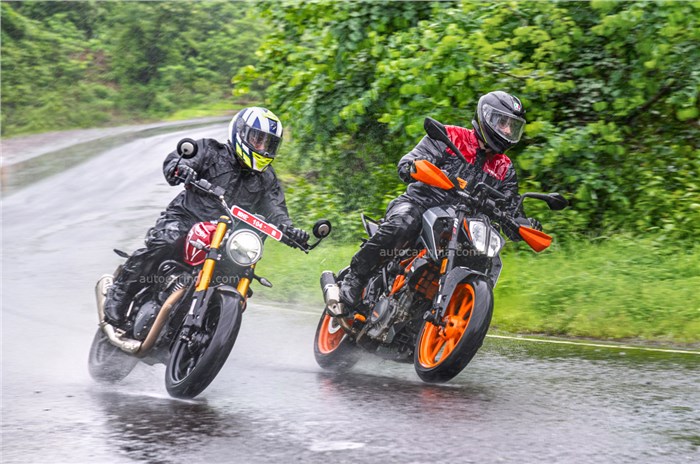They seem quite similar on paper so we took these two Bajaj-built motorcycles to see what they’re like in reality.
Published On Jul 27, 2023 07:00:00 AM
When we rode the new Triumph Speed 400 for the first time in isolation we couldn’t help but feel some similarities to the KTM 390 Duke. This was in terms of how quick it felt, how agile it was, the sound it made, how slim it felt between the legs – there were a number of parallels. So to see just how similar the two bikes are, we got them together and tested them back to back. Doing so has revealed that they’re both actually very distinct bikes with fairly different characters, and our testing threw up some surprise results.
The 373cc KTM engine may be smaller than the 398cc Triumph, but it produces more peak power at 43.5hp vs 40hp. The torque figures are almost identical with 37.5Nm for the Triumph and 37Nm for the KTM, but the former’s peak torque is produced at lower revs.
While that all sounds very close, the performance is actually very different. Riding these two bikes back-to-back, the KTM actually feels quite lethargic and gutless at the bottom of the rev range. It needs quite a bit of throttle to get around, and feels rather clattery and juddery at low speeds. It’s only from about 4000rpm onwards that it starts to get happier, and from there on, the higher the tachometer climbs, the better this engine feels – It pulls clean and hard, and the vibrations begin to reduce. All this reaches a wonderful crescendo at the top of the rev range, where the KTM delivers a real rush from 8000 to 10,000rpm which is always super entertaining.

It’s a very different story with the Triumph’s motor. You don’t get a high RPM rush, but where this engine shines is in its tractability and its mid-range. Right from idle, it feels very smooth, willing and eager, and it’s more than happy to pull you around at low RPMs in the city with very small throttle inputs. And then once you get to about 3 to 4 thousand RPM, it properly comes alive and begins to surge forward enthusiastically. It pulls hard till about 7 to 7.5 thousand RPM and then gradually trails off as you climb to the 9.2k RPM redline.
The KTM is over 1 second quicker from 0-100kph, but in our in-gear acceleration tests, it was actually the Triumph that emerged quicker every single time. And this paints a much better picture of real world usability. The Triumph’s much more accessible powerband means that you can use more of the performance, more of the time, with much less effort. You’re less likely to need a downshift when trying to claim a gap that just opened up in traffic, or overtaking on the highway, and this means that the performance here feels much easier and more effortless than it does on the KTM.
As for fuel efficiency, despite being a slightly larger engine, the Triumph manages to be a little more fuel efficient than the KTM. This is mostly because you don’t need as much throttle and revs to get around on the Speed.
At Rs 2.33 lakh, the Speed 400 is an incredibly capable motorcycle at an almost unbelievable price. The Duke, meanwhile, has gradually crept up in price over the years, and now sits at Rs 2.97 lakh, making it over Rs 60,000 more expensive than the Triumph. That said, it does throw in some more features, including adjustable levers, a bi-directional quickshifter and a Bluetooth-equipped TFT display. Triumph has given the Speed a simpler dash with smart digi-analogue clocks (sans Bluetooth), though it does get traction control which the KTM misses out on.
That being said, the KTM is definitely the more characterful and exciting motorcycle and if those are your top priorities, it will be the better choice. And lets not forget, there’s a brand new KTM 390 Duke coming soon which promises to bring the biggest update seen since the original launched ten years back
For a more in-depth comparison of what these two bikes have to offer, click here to watch our video comparison review.
Copyright (c) Autocar India. All rights reserved.


